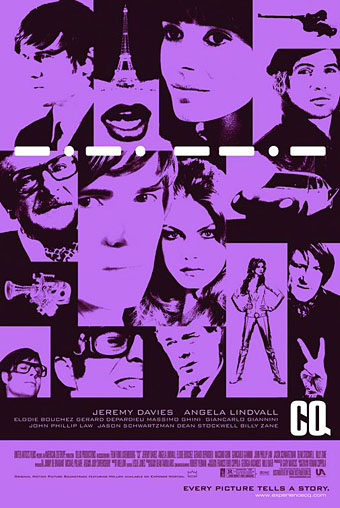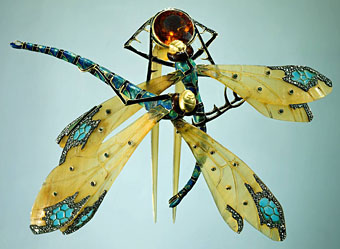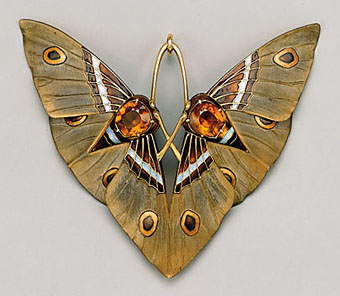A belated shout of appreciation for this film whose distribution appears to have been so limited that everyone missed it, me included. That’s a shame as Roman Coppola’s debut (he’s the son of Francis) has a lot to commend it although it helps if you’re familiar with pulpy European spy/science fiction/horror movies of the late Sixties and the po-faced works of auteurs such as Jean-Luc Godard and Michelangelo Antonioni. CQ pays loving homage to both styles of filmmaking which probably explains why the studio didn’t know what to do with it.
Category: {design}
Design
Lucien Gaillard
Two dragonflies (1904).
Art Nouveau insect jewellery by Lucien Gaillard (1861–1933).
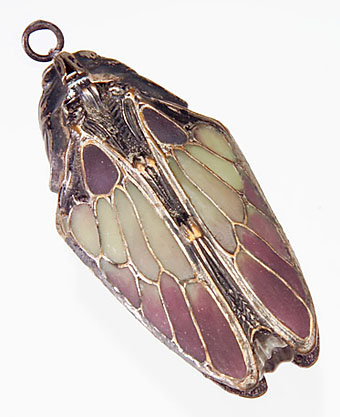
Perfume bottle (?) (c. 1923).
Moth pendant (1900).
And while we’re on the subject, a display of precious stones and metals has opened at London’s Natural History Museum in a new gallery they’re calling The Vault.
Previously on { feuilleton }
• Wesley Fleming’s glass insects
• The art of Sergei Aparin
• Insect Lab
• The glass menagerie
• The Museum of Fantastic Specimens
Stevenson and the dynamiters
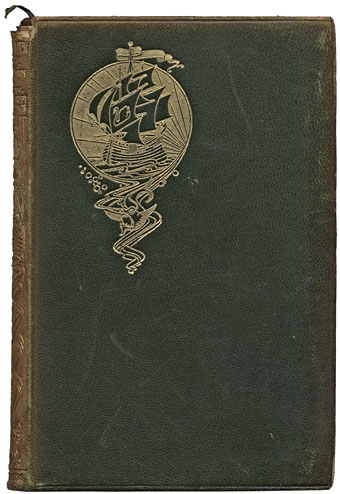
The Dynamiter: More New Arabian Nights (Longmans, London; 1914).
I’ve mentioned before that I’m a sporadic collector of the Tusitala Edition of Robert Louis Stevenson’s works, 35 small blue volumes published by Heinemann, London in 1924. I’ve found 15 of them so far and today turned up another one, volume 25, Virginibus Pueresque and Other Essays in Belles Lettres. Most of the ones I’ve collected are later reprints and this is no exception, being a sixth edition from 1928. The popularity of the series and the many reprint editions is the main reason they still appear with such frequency. Another reason is that these small pocket books, which were very common before and after the First World War, were well-made and have easily outlasted the first generation of paperbacks that eventually replaced them. I’d have no trouble ordering a complete set of the Stevensons from a book dealer but prefer to let chance find new additions. Given the dearth of good secondhand shops this is becoming increasingly difficult.
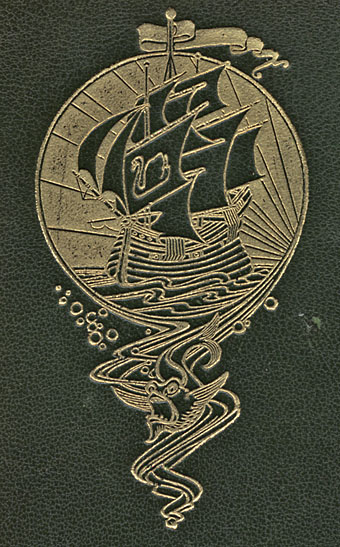
Also in today’s book haul was an earlier Stevenson, The Dynamiter: More New Arabian Nights, in a rather battered leather binding from 1914. I bought it almost solely for the Art Nouveau motif on the cover whose ship suits the author of Treasure Island but doesn’t really fit with the London setting of this particular book. I seem to recall having seen this design before which means it’s probably part of a uniform set like the Tusitala Edition, each volume of which bears a palm tree design on the spine and the signature of RLS blocked on the front board.
The only number of the Tusitala Edition I have in a leather binding is this book’s precursor, volume 1, New Arabian Nights. The Dynamiters is a collection of linked stories that Stevenson wrote with his wife, the Arabian Nights conceit being an attempt to transplant the telling of tall tales from medieval Baghdad to Victorian London. The dynamiters are a group of inept terrorists whose comic exploits were based on the real Fenian bombings that took place in London in the 1880s. A later attempted bomb attack on the Greenwich Observatory inspired the unsuccessful anarchists in Joseph Conrad’s The Secret Agent. Whatever some contemporary commentators might have us believe, terrorist attacks in cities are nothing new at all, only in Stevenson’s day they were labelled “dynamite outrages”. Stevenson dedicates his stories to the police officers charged with protecting the capital and apologises for making light of a serious matter. I have to wonder what he would have made of modern Baghdad being plagued by dynamite outrages on such a regular basis. And I also wonder how much real dynamite many of these Longmans’ books might have encountered, having been published just in time to be packed in the kit of soldiers going to the Western Front.
Elsewhere on { feuilleton }
• The book covers archive
Previously on { feuilleton }
• The Chronicles of Clovis and other sarcastic delights
Refreshing The Wire
Refreshing The Wire
| Redesigned website for the music mag.
New things for November II
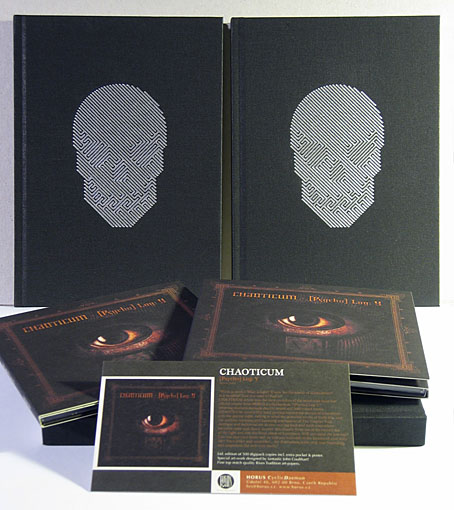
It’s always nice when something you’ve worked on turns up in the post and there’s been a double helping of that this week with the arrival of the Chaoticum CD and the catalogue for the Maison D’Ailleurs exhibition. Since both of these are either partly or wholly connected to HP Lovecraft, their simultaneous arrival is fitting.
The CD is a digipak on textured art paper and another quality production from Horus CyclicDaemon. The exhibition catalogue manifested as a small hardback book which was a pleasant surprise, with the skull maze design blocked in silver on the cover. Each artist is allotted a single page and the book also includes some original fiction based on Lovecraft’s story notes by a number of well-known writers. My picture is rather shrunken the way it’s positioned across the centre of a page (would have been better running vertically) but then it was my decision to make it so wide in the first place.
The Chaoticum CD is limited to 500 copies and can be ordered here. The catalogue is available from Maison D’Ailleurs or the Payot Libraire bookstore for CHF 37.00 + p&p (or 38, depending on which page you look at).
Also arriving this week is my illustration of ex-Sun City Girls guitarist Sir Richard Bishop for an Arthur Magazine interview by Erik Davis. Arthur #27 will be hitting the stands in the US and Canada shortly but for now you can download it in PDF form here.
Previously on { feuilleton }
• Lovecraftian horror at Maison d’Ailleurs
• New things for October

